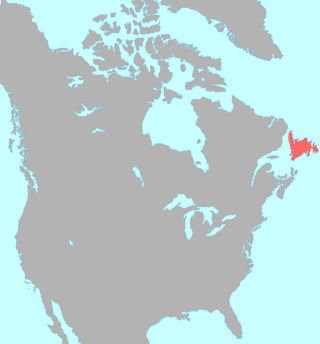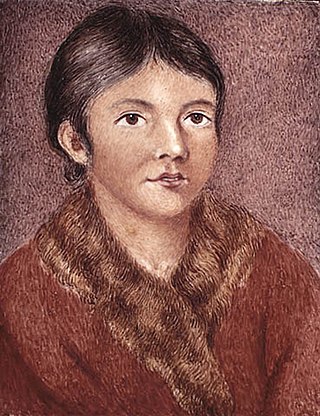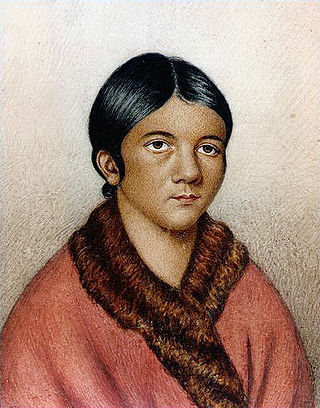
The Beothuk were a group of indigenous people who lived on the island of Newfoundland.

The Exploits River is a river in the province of Newfoundland and Labrador, Canada. It flows through the Exploits Valley in the central part of Newfoundland.

Beothuk, also called Beothukan, is an extinct language once spoken by the indigenous Beothuk people of Newfoundland. The Beothuk have been extinct since 1829, and there are few written accounts of their language. Hence, little is known about it, with practically no structural data existing for Beothuk.

Admiral Sir Charles Hamilton, 2nd Baronet KCB, was a British naval officer and commodore-governor of Newfoundland.

Demasduit was a Beothuk woman, one of the last of her people on Newfoundland.

Shanawdithit, also noted as Shawnadithit, Shawnawdithit, Nancy April and Nancy Shanawdithit, was the last known living member of the Beothuk people, who inhabited Newfoundland, Canada. Remembered for her contributions to the historical understanding of Beothuk culture, including drawings depicting interactions with European settlers, Shanawdithit died of tuberculosis in St. John's, Newfoundland on June 6, 1829.
David Buchan was a Scottish naval officer and Arctic explorer.
William Epps Cormack was a Scottish explorer, philanthropist, agriculturalist and author, born St. John's, Newfoundland. Cormack was the first person of European descent to journey across the interior of the island. His account of his travels was first published in Britain in 1824. Interested in studying and trying to preserve Native culture, he founded the Beothick Institution in 1827.
Sylvester Joe, hunter and explorer, born Baie d'Espoir, Newfoundland. Joe, a native Mi'kmaq of Newfoundland, was the noted hunter from the south-west coast of the island of Newfoundland who was engaged by William Cormack to guide him on his trek across Newfoundland, the first European Canadian to do so.
Beothuk Lake, formerly Red Indian Lake, is located in the interior of central Newfoundland in the province of Newfoundland and Labrador, Canada. The lake drains into the Exploits River which flows through the interior of Newfoundland and exits into the Atlantic Ocean through the Bay of Exploits. Lloyds River, the Victoria River and Star River feed into the lake.
The Maritime Archaic is a North American cultural complex of the Late Archaic along the coast of Newfoundland, the Canadian Maritimes and northern New England. The Maritime Archaic began in approximately 7000 BC and lasted until approximately 3500 BC, corresponding with the arrival of the Paleo-Eskimo groups who may have outcompeted the Maritime Archaic for resources. The culture consisted of sea-mammal hunters in the subarctic who used wooden boats. Maritime Archaic sites have been found as far south as Maine and as far north as Labrador. Their settlements included longhouses, and boat-topped temporary or seasonal houses. They engaged in long-distance trade, as shown by white chert from northern Labrador being found as far south as Maine.

Henrietta Martha, Lady Hamilton (1780–1857) was born in Stanmore, Middlesex, England, and was the wife of Sir Charles Hamilton, Governor of Newfoundland. She is best known for her miniature portrait entitled Mary March. The painting is a watercolour on ivory of an aboriginal Beothuk Demasduit, and is considered by many to be the only representation of an aboriginal Beothuk taken from life. It was painted in 1819 at St. John's where she lived with her husband during his term as governor from 1818 to 1824.

Boyd's Cove, also known as Boyd's Harbour, is a local service district and designated place in the Canadian province of Newfoundland and Labrador that is near Lewisporte. There is an interpretive centre dedicated to the earlier indigenous Beothuk settlement at this location.

Peterview is a town located in the Exploits Valley area of central Newfoundland and Labrador, Canada, where Peters River empties into the Bay of Exploits, just south of Botwood, off Route 350.
Noel Joseph JeddoreWe’jitu also Newell Jeddore Gietol, Geodol was Saqamaw "grand chief" of the Mi'kmaq at Miawpukek in Bay d'Espoir on the south coast of Newfoundland in the Coast of Islands region. Jeddore served as chief from July 26, 1919 until he was forced into exile to Eskasoni, Nova Scotia, in 1924. He was born at Indian Point, Bay d'Espoir and he died at Eskasoni, Cape Breton.
South Brook is a town in the Canadian province of Newfoundland and Labrador. It is located in the center region of the island of Newfoundland. The town had a population of 420 in 2021, down from 482 in the Canada 2016 Census.

Newfoundland is a large island situated off the eastern coast of the North American mainland and the most populous part of the Canadian province of Newfoundland and Labrador. The island contains 29 percent of the province's land area. The island is separated from the Labrador Peninsula by the Strait of Belle Isle and from Cape Breton Island by the Cabot Strait. It blocks the mouth of the Saint Lawrence River, creating the Gulf of Saint Lawrence, the world's largest estuary. Newfoundland's nearest neighbour is the French overseas collectivity of Saint Pierre and Miquelon.

Newfoundland was an English and, later, British colony established in 1610 on the island of Newfoundland, now the province of Newfoundland and Labrador. That followed decades of sporadic English settlement on the island, which was at first seasonal, rather than permanent. It was made a Crown colony in 1824 and a Dominion in 1907. Its economy collapsed during the Great Depression and on 16 February 1934, the Newfoundland legislature agreed to the creation of a six-member Commission of Government to govern the country. In 1949, the country voted to join Canada as the province of Newfoundland.

The Qalipu First Nation, is a Mi’kmaq band government, created by order-in-council in 2011 pursuant to the Agreement for the Recognition of the Qalipu Mi’kmaq Band. After the band was approved as a First Nation, 100,000 people applied for membership and a total of 23,000 were approved.
John Peyton Sr. (1749–1829) was an English-born fisherman and trapper in the Colony of Newfoundland.










